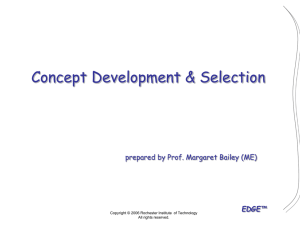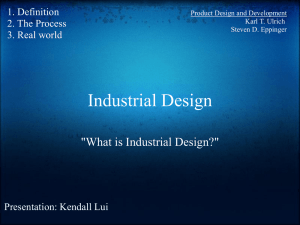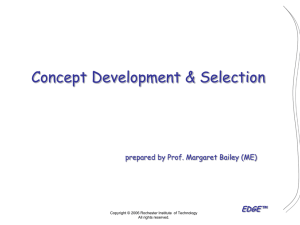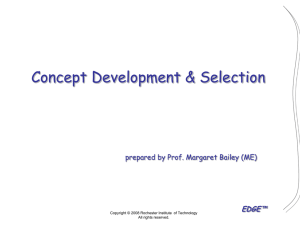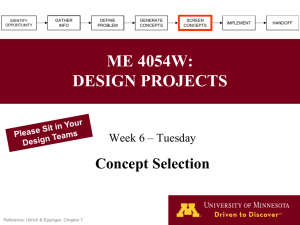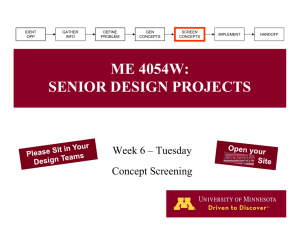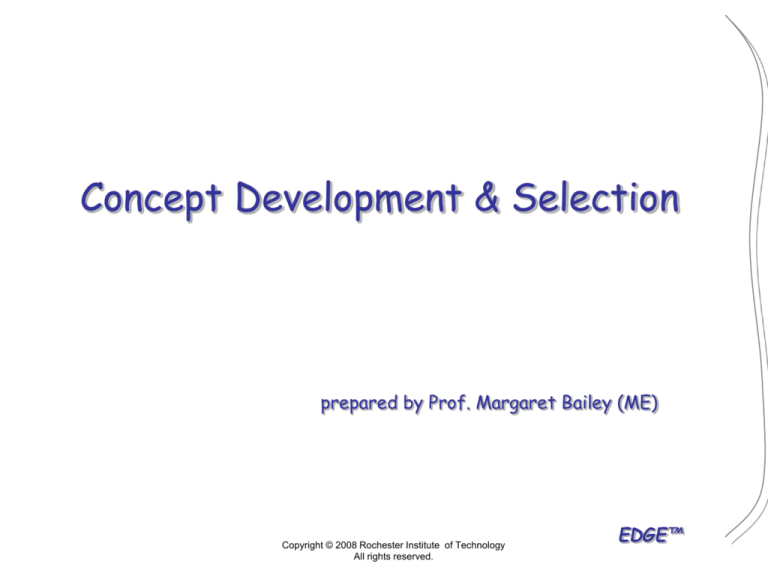
Concept Development & Selection
prepared by Prof. Margaret Bailey (ME)
Copyright © 2008 Rochester Institute of Technology
All rights reserved.
EDGE™
Today’s Workshop Overview
• 9am –10:30AM
• 10:30 – Noon
• Noon– 1:00 PM
• 2:00 – 4:00
• 4:00 – 4:30
• By 5:00 PM
Interactive Exercise on
Concept Development & Selection
Concept Development & Selection
on Team Project
Optional Tutorial: Prepare for Design
Reviews (Xerox Auditorium)
Continue Selection Process:
Concept Scoring, Customer Feedback
Create Summary of Activities
Review Team Concept
Development and Selection
Activities with Guide
EDGE™
Session Overview
• Introduce Concept Development &
Selection Process
• Explore Two-Stage Methodology
• Demonstrate Above Steps on Example
• Discuss Common Dysfunctions Associated
with this Phase
• Apply Concept Development & Selection
Process to Team MSD I Project
EDGE™
Concept Development & Selection Process
Mission
Statement
Identify
Customer
Needs
Establish
Target
Specifications
Generate
Product
Concepts
Select
Product
Concept(s)
Test
Product
Concept(s)
Set
Final
Specifications
Plan
Downstream
Development
Development
Plan
Perform Economic Analysis
Benchmark Competitive Products
Build and Test Models and Prototypes
These activities can occur
throughout the design
process!
Karl T. Ulrich and Steven D. Eppinger, 2008, Product Design and
Development, Exhibit 7-2, Chapter 7, 4th Edition, p. 125, Irwin McGraw-Hill
EDGE™
Concept Development &
Selection Process
Concepts
Scoring
Stage
Selection Criteria
Screening
Stage
Concept Ratings
Winning Concept(s)
Goal: The goal is not to select the best
concept but to develop the best concept
by combining and/or refining
EDGE™
Concept Development & Selection
Funnel
concept generation
concept screening
concept scoring
concept testing
Karl T. Ulrich and Steven D. Eppinger, 2008, Product Design and Development,
Exhibit 7-4, Chapter 7, 4th Edition, p. 128, Irwin McGraw-Hill
EDGE™
Concept Selection Process
Screening Stage
Prepare the Matrix
Rate Concepts
Rank Concepts
Combine and Improve
Select Best Concept
Reflect on the Process
Scoring Stage
Prepare the Matrix
Rate Concepts
Rank Concepts
Combine and Improve
Select Best Concept
Reflect on the Process
EDGE™
Concept Selection Example:
Reusable Syringe
Karl T. Ulrich and Steven D. Eppinger, 2008, Product Design and
Development, Exhibit 7-1, Chapter 7, 4th Edition, p. 123, Irwin McGraw-Hill
EDGE™
Concept Selection Example:
Reusable Syringe
• Design an improved, reusable syringe with
precise dosage control for outpatient use.
– Current product was too costly and inaccurate
• Seven criteria identified based on customer
needs
– Ease of handling, use and manufacture
– Readability of dose settings and accuracy
– Durability and portability
• Seven overall product concepts proposed
(Exhibit 7-3, pp. 126-127)
EDGE™
Concept Development & Selection
Funnel
concept generation
concept screening
concept scoring
concept testing
Karl T. Ulrich and Steven D. Eppinger, 2008, Product Design and
Development, Exhibit 7-4, Chapter 7, 4th Edition, p. 128, Irwin McGraw-Hill
EDGE™
Screening Stage
Concepts which made the first cut
• Prepare the Matrix – Pugh's
METHOD
– Criteria
– Select Reference Concept
• Rate Concepts
– Scale (+ – 0)
– Compare to Reference
Concept
• Rank Concepts
• Combine and Improve
– Remove Bad Features
– Combine Good Qualities
• Select Best Concepts
– May Be More than One
– Beware of Average Concepts
• Reflect on the Process
– Continuous Improvement
Karl T. Ulrich and Steven D. Eppinger, 2008, Product Design and Development,
Exhibits 7-3 and 7-5, Chapter 7, 4th Edition, pp. 126 & 130, Irwin McGraw-Hill
EDGE™
Examples of Concept Generation
Karl T. Ulrich and Steven D. Eppinger, 2008,
Product Design and Development, Exhibit 7-3,
Chapter 7, 4th Edition, p. 126, Irwin McGraw-Hill
Concepts need to be well-defined
PRIOR to concept evaluation!
(neither of these concepts made
the screening cut) EDGE™
Determine Criteria and Reference
Concept
• In teams begin
preparing the Matrix –
Pugh's METHOD
– Establish a preliminary list of
the subsystems which will
involve a matrix for concept
selection
– Determine Selection Criteria
for several of the above
subsystems
– Select a Reference Concept
for each matrix
EDGE™
Screening Stage
• Pugh's METHOD
– Criteria
– Select Reference Concept
Concepts which made the first
cut BUT more refinement
required before SCORING
process
• Rate Concepts
– Scale (+ – 0)
– Compare to Reference
Concept
• Rank Concepts
• Combine and Improve
– Remove Bad Features
– Combine Good Qualities
• Select Best Concepts
– May Be More than One
– Beware of Average Concepts
• Reflect on the Process
– Continuous Improvement
Karl T. Ulrich and Steven D. Eppinger, 2008, Product Design and Development,
Exhibits 7-3 and 7-5, Chapter 7, 4th Edition, pp. 126 & 130, Irwin McGraw-Hill
EDGE™
Identify “Winning” Concepts
Concept A has highest net
score and no “worse than”
ratings
Karl T. Ulrich and Steven D. Eppinger, 2008, Product Design and Development,
Exhibit 7-3, Chapter 7, 4th Edition, p. 126, Irwin McGraw-Hill
EDGE™
Combine Winning Concepts
Concepts D & F were
combined to eliminate
“worse than” ratings
Karl T. Ulrich and Steven D. Eppinger, 2008, Product Design and Development,
Exhibit 7-3 & 7-6, Chapter 7, 4th Edition, pp. 127 & 133, Irwin McGraw-Hill
EDGE™
Refine Winning Concepts
Concept G’s scored well but
ease of handling was a
problem, therefore revise!
Karl T. Ulrich and Steven D. Eppinger, 2008, Product Design and Development,
Exhibit 7-3 & 7-6, Chapter 7, 4th Edition, pp. 127 & 133, Irwin McGraw-Hill
EDGE™
Screening Stage for MSD I Project
• In teams
– Prepare the Concept Screening Matrix (Exhibit 7-5,
p. 130)
– Begin the following (and finish today!):
• Rate and Rank Concepts
• Combine and Revise
• Select Best Concept(s)
• Proceed onto Concept Scoring Process
EDGE™
Concept Development & Selection
Funnel
concept generation
concept screening
concept scoring
concept testing
Karl T. Ulrich and Steven D. Eppinger, 2008, Product Design and
Development, Exhibit 7-4, Chapter 7, 4th Edition, p. 128, Irwin McGraw-Hill
EDGE™
Scoring Stage
•
REFINE Pugh’s Matrix
•
Rate Concepts
•
Rank Concepts
•
Combine and Improve
•
Select Best Concepts
•
Reflect on the Process
– Criteria
– ADD Weightings
– REFINE Scale (1 - 5)
– Select “Average” Criteria for
Reference
– Compare to Reference Criteria
– Sum Weighted Scores
– Remove Bad Features
– Combine Good Qualities
– May Be More than One
– Continuous Improvement
Karl T. Ulrich and Steven D. Eppinger, 2008, Product Design and
Development, Exhibit 7-7, Chapter 7, 4th Edition, p. 134, Irwin McGraw-Hill
EDGE™
Generated from
Customer Needs
– week 1
Example: Concept Scoring
Concepts
A
(re fere nce)
M as te r Cylinder
DF
E
G+
Le ver Stop
Sw as h Ring
Dial Scre w +
Weight
Rating
Weighted
Score
5%
3
0.15
3
0.15
4
0.2
4
0.2
Ease of Use
15%
3
0.45
4
0.6
4
0.6
3
0.45
Readability of Settings
10%
2
0.2
3
0.3
5
0.5
5
0.5
Dose Metering Accuracy
25%
3
0.75
3
0.75
2
0.5
3
0.75
Durability
15%
2
0.3
5
0.75
4
0.6
3
0.45
Ease of Manuf acture
20%
3
0.6
3
0.6
2
0.4
2
0.4
Portability
10%
3
0.3
3
0.3
3
0.3
3
0.3
Se le ction Crite ria
Ease of Handling
Total Score
Rank
Continue?
Rating
Weighted
Score
Rating
Weighted
Score
Rating
Weighted
Score
2.75
3.45
3.10
3.05
4
1
2
3
No
Develop
No
No
Need to revisit PUGH Matrix as your
team’s knowledge base expands
Karl T. Ulrich and Steven D. Eppinger, 2008, Product Design and
Development, Exhibit 7-7, Chapter 7, 4th Edition, p. 134, Irwin McGraw-Hill
EDGE™
Final Winning Concept - DF
Concept DF was selected as the winning concept HOWEVER:
Do not simply select concept was highest rating – conduct a
sensitivity study by varying weights and ratings and examine
effect on winning concept rating. Does uncertainty about a
particular value have a large impact on the winning concept?
Team could have decided to go with top two (or more) concepts.
Concepts could be prototyped and tested for customer feedback.
Karl T. Ulrich and Steven D. Eppinger, 2008, Product Design and Development,
Exhibit 7-6, Chapter 7, 4th Edition, p. 133, Irwin McGraw-Hill
EDGE™
Tips for Concept Development & Selection
• When possible, use objective rather
subjective criteria
• Useful to identify strengths of concepts that
do not make it through screening/scoring
stages – could these be incorporated on
winning concept(s)?
• Include ease of manufacture, reduced
liability, and/or cost as criteria
• Use concept development & selection process
throughout MSD I and MSD II
EDGE™
Concept Development & Selection
Funnel
concept generation
concept screening
concept scoring
concept testing
Karl T. Ulrich and Steven D. Eppinger, 2008, Product Design and
Development, Exhibit 7-4, Chapter 7, 4th Edition, p. 128, Irwin McGraw-Hill
EDGE™
Test Product Concepts
Mission
Statement
Identify
Customer
Needs
Establish
Target
Specifications
Generate
Product
Concepts
Select
Product
Concept(s)
Test
Product
Concept(s)
Set
Final
Specifications
Plan
Downstream
Development
Development
Plan
Perform Economic Analysis
Benchmark Competitive Products
Build and Test Models and Prototypes
Helps in further exploring concepts…
Which concept should be pursued?
How can the concept be improved to better meet customer needs?
Should development continue?
TOOL: Survey customer response, refer to Chapter 8 for more details
Karl T. Ulrich and Steven D. Eppinger, 2008, Product Design and Development,
Exhibit 8-2, Chapter 8, 4th Edition, p. 146, Irwin McGraw-Hill
EDGE™
Practice Concept Development &
Selection on MSD I Project
• Continue Team Screening Stage and start
Scoring Stage
Screening and
Scoring Stages
Prepare/Refine the Matrix
Rate Concepts
Rank Concepts
Combine and Improve
Select Best Concept
Reflect on the Process
Sample Excel
Spreadsheet
Available for
PUGH
EDGE™
Rest of the Day….
• Start with Concepts Associated with Critical Sub-function(s)
Identified During Week 3
– Develop Pugh's Matrix for SCREENING Process
• Create Criteria, Select Reference Concept, Rate Concepts
(Scale (+ – 0)), Compare to Reference Concepts, Rank Concepts,
• Combine and Improve, Remove Bad Features, Combine Good
Qualities, Select Best Concepts
• Refer to Exhibit 7-5
– Refine Pugh's Matrix during SCORING Process
• Refine Criteria, ADD Weightings, Rate Concepts (Scale (1 - 5)),
Select “Average” Criteria for Reference, Determine Sum
Weighted Scores
• Combine and Improve, Remove Bad Features, Combine Good
Qualities, Select Best Concepts
• Refer to Exhibit 7-7
– Get customer feedback, if possible
• Attend Optional Tutorial at Noon today in Xerox!
EDGE™
For Next Week
• Complete concept selection process (quickly)
• Begin system level design: architecture, subsystem definition, interface definition
• Schedule and prepare for Concept/System
Design Review
– Take ownership of meeting(s) – who should attend?
EDGE™
Weeks 5 - 7: Concept/System
Design Review
• You may decide to hold separate reviews
of concept development & system design
• In-depth meeting(s) with Guide,
Consultant(s), peers, customer(s), and
appropriate experts
• Minimize “presentation”, maximize valueadded discussion (see Guidelines on EDGE)
• Grading: 6% for concept generation &
selection; 15% for system design & review
(see Rubric on EDGE)
EDGE™
Concept/System Design Review- Content
• Discuss concept selection & improvement process
• System-level design: architecture, subsystems,
interfaces
• Identify high-risk technologies and perform enough
modeling and/or simulation (computer-based or
physical mock-up) to demonstrate that the project
can be successful
– may include features such as new technology, previously
untested technology, long-lead time or prohibitively
expensive components
• Additional specific requirements should be agreed on
with Guide
• TEAM Goal: get useful feedback from reviewers
EDGE™
Concept Generation and
Evaluation (TEAM GRADE)
Creative concepts were generated at the system & subsystem
level, and evaluated against customer-oriented criteria and
competing products.
(3 points max)
Concept Improvement and
Selection
(TEAM GRADE)
Team clearly took advantage of the evaluation process to
improve or combine existing concepts or to uncover fixable
weaknesses, and the selection process was structured and
effective.
(3 points max)
System-Level Design
Systems architecture, subsystems, and interfaces are clearly
defined and consistent with selected concepts.
(4 points max)
Engineering Analysis
Modeling and/or simulation necessary for system-level design
is complete, including accurate operating conditions and input
parameters.
(4 points max)
Risk Assessment (high
technology) and Proof-of-Concept
High-risk technologies have been identified, and breadboard/
simulation has demonstrated feasibility of system-level
design. Risks for cost and schedule have been identified and
assessed.
(4 points max)
Concept/System Design Review
Execution
Design review(s) held with appropriate attendees, all key
issues were discussed, notes and action items are
documented.
EDGE™
(3 points max)

